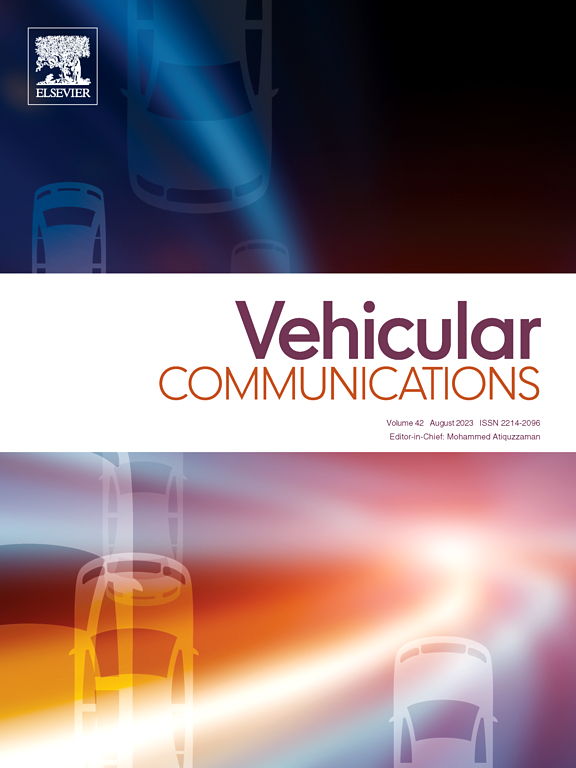UAV-assisted Internet of vehicles: A framework empowered by reinforcement learning and Blockchain
IF 6.5
2区 计算机科学
Q1 TELECOMMUNICATIONS
引用次数: 0
Abstract
This paper addresses the challenges of selecting relay nodes and coordinating among them in UAV-assisted Internet-of-Vehicles (IoV). Recently, UAVs have gained popularity as relay nodes to complement vehicles in IoV networks due to their ability to extend coverage through unbounded movement and superior communication capabilities. The selection of UAV relay nodes in IoV employs mechanisms executed either at centralized servers or decentralized nodes, which have two main limitations: 1) the traceability of the selection mechanism execution and 2) the coordination among the selected UAVs, which is currently offered in a centralized manner and is not coupled with the relay selection. Existing UAV coordination methods often rely on optimization methods, which are not adaptable to different environment complexities, or on centralized deep reinforcement learning, which lacks scalability in multi-UAV settings. Overall, there is a need for a comprehensive framework where relay selection and coordination processes are coupled and executed in a transparent and trusted manner. This work proposes a framework empowered by reinforcement learning and Blockchain for UAV-assisted IoV networks. It consists of three main components: a two-sided UAV relay selection mechanism for UAV-assisted IoV, a decentralized Multi-Agent Deep Reinforcement Learning (MDRL) model for efficient and autonomous UAV coordination, and finally, a Blockchain implementation for transparency and traceability in the interactions between vehicles and UAVs. The relay selection considers the two-sided preferences of vehicles and UAVs based on the Quality-of-UAV (QoU) and the Quality-of-Vehicle (QoV). Upon selection of relay UAVs, the coordination between the selected UAVs is enabled through an MDRL model trained to control their mobility and maintain the network coverage and connectivity using Proximal Policy Optimization (PPO). MDRL offers decentralized control and intelligent decision-making for the UAVs to maintain coverage and connectivity over the assigned vehicles. The evaluation results demonstrate that the proposed selection mechanism improves the stability of the selected relays, while MDRL maximizes the coverage and connectivity achieved by the UAVs. Both methods show superior performance compared to several benchmarks.
无人机辅助车辆互联网:强化学习和区块链授权的框架
本文研究了无人机辅助车联网中中继节点的选择与协调问题。最近,由于无人机能够通过无限移动和卓越的通信能力扩展覆盖范围,因此无人机作为物联网网络中车辆的补充中继节点而受到欢迎。物联网中无人机中继节点的选择采用在集中式服务器或分散节点上执行的机制,这有两个主要限制:1)选择机制执行的可追溯性;2)所选无人机之间的协调,目前以集中方式提供,不与中继选择相耦合。现有的无人机协调方法往往依赖于优化方法,不能适应不同的环境复杂性,或者依赖于集中式深度强化学习,缺乏多无人机环境下的可扩展性。总的来说,需要一个全面的框架,其中中继选择和协调过程以透明和可信的方式耦合和执行。这项工作提出了一个由强化学习和区块链授权的框架,用于无人机辅助的物联网网络。它由三个主要部分组成:用于无人机辅助物联网的双边无人机中继选择机制,用于高效自主无人机协调的分散多智能体深度强化学习(MDRL)模型,以及用于车辆和无人机之间交互透明度和可追溯性的区块链实现。在无人机质量(QoU)和飞行器质量(QoV)的基础上,考虑了车辆和无人机的双边偏好。在选择中继无人机后,所选无人机之间的协调通过MDRL模型进行训练,以控制其机动性并使用近端策略优化(PPO)保持网络覆盖和连通性。MDRL为无人机提供分散控制和智能决策,以保持对指定车辆的覆盖和连接。评估结果表明,所提出的选择机制提高了所选中继的稳定性,同时MDRL最大化了无人机的覆盖和连通性。与几个基准测试相比,这两种方法都显示出优越的性能。
本文章由计算机程序翻译,如有差异,请以英文原文为准。
求助全文
约1分钟内获得全文
求助全文
来源期刊

Vehicular Communications
Engineering-Electrical and Electronic Engineering
CiteScore
12.70
自引率
10.40%
发文量
88
审稿时长
62 days
期刊介绍:
Vehicular communications is a growing area of communications between vehicles and including roadside communication infrastructure. Advances in wireless communications are making possible sharing of information through real time communications between vehicles and infrastructure. This has led to applications to increase safety of vehicles and communication between passengers and the Internet. Standardization efforts on vehicular communication are also underway to make vehicular transportation safer, greener and easier.
The aim of the journal is to publish high quality peer–reviewed papers in the area of vehicular communications. The scope encompasses all types of communications involving vehicles, including vehicle–to–vehicle and vehicle–to–infrastructure. The scope includes (but not limited to) the following topics related to vehicular communications:
Vehicle to vehicle and vehicle to infrastructure communications
Channel modelling, modulating and coding
Congestion Control and scalability issues
Protocol design, testing and verification
Routing in vehicular networks
Security issues and countermeasures
Deployment and field testing
Reducing energy consumption and enhancing safety of vehicles
Wireless in–car networks
Data collection and dissemination methods
Mobility and handover issues
Safety and driver assistance applications
UAV
Underwater communications
Autonomous cooperative driving
Social networks
Internet of vehicles
Standardization of protocols.
 求助内容:
求助内容: 应助结果提醒方式:
应助结果提醒方式:


